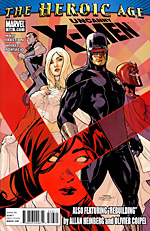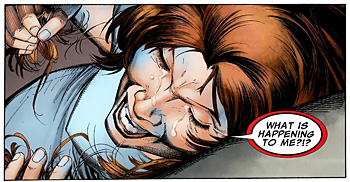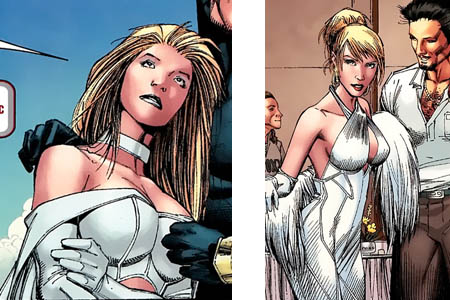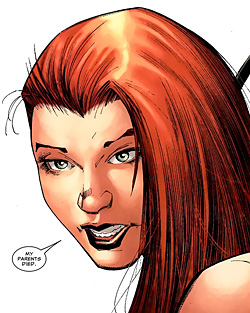 Written by Matt Fraction with Allan Heinberg
Written by Matt Fraction with Allan Heinberg
Penciled by Whilce Portacio with Olivier Coipel
Inked by Ed Tadeo with Mark Morales
40 pages, color
Published by Marvel Comics
After the conclusion of the "Second Coming" crossover throughout the X-Men family of titles, I’ve been eagerly awaiting the latest Uncanny X-Men. It’s my favorite of the mutant titles, to be fair, but writer Matt Fraction left us with such a nice cliffhanger at the end of "Second Coming" that it’s been hard to not want to see more. And so far? It’s hard to not feel a little perplexed by the choice of artist for the next five months.
 On the plus side, Fraction’s script is hitting all the major plot points that have been seemingly on hold for the last several years. We’re starting to see forward movement on the lack of additional mutant births in the Marvel Universe, and the X-Men are just now starting to look into the parentage of Hope Summers. It’s been hard to ignore these stories, although Fraction’s admittedly kept things busy enough that it almost works that just now the X-Men are getting a chance to stop, catch their collective breath, and finally ask the question, "What next?" And as for the story itself, it’s fun. Fraction is addressing the question of just why Hope Summers will be seen as the savoir of the mutant race in the future, and the answer is not only from the last pages of Second Coming #2, but also now adds an additional wrinkle and caveat into the mix. It makes Hope’s status that much more important, and I’m intrigued with just where they’re going with the longer story.
On the plus side, Fraction’s script is hitting all the major plot points that have been seemingly on hold for the last several years. We’re starting to see forward movement on the lack of additional mutant births in the Marvel Universe, and the X-Men are just now starting to look into the parentage of Hope Summers. It’s been hard to ignore these stories, although Fraction’s admittedly kept things busy enough that it almost works that just now the X-Men are getting a chance to stop, catch their collective breath, and finally ask the question, "What next?" And as for the story itself, it’s fun. Fraction is addressing the question of just why Hope Summers will be seen as the savoir of the mutant race in the future, and the answer is not only from the last pages of Second Coming #2, but also now adds an additional wrinkle and caveat into the mix. It makes Hope’s status that much more important, and I’m intrigued with just where they’re going with the longer story.
 Unfortunately, Whilce Portacio has proven over the years to be one of the most wildly inconsistent pencilers in comics to also become a big name. Portacio isn’t just someone who can turn out a beautiful comic one month and a questionable one the next, he’s someone who often hits his highs and lows within the same comic. Take, for example, his depictions of Emma Frost in Uncanny X-Men #526. On one page, she’s a vacant-looking, expressionless person that’s only recognizable by her outfit. Her eyes are too wide apart, her face is a big melon slapped onto a neck, her hair looks like it hasn’t been washed in years, and her vision doesn’t appear to be focusing properly. Then you turn the page, and we get the glamorous Emma Frost. It’s not that she’s dressed for success for an evening out with Tony Stark, though, but rather that looking at the faces of Emma Frost they don’t even appear to be the same character, save for the outfit. Her head is suddenly narrower, her eyes smaller, even her neck is a little shorter. It’s hard to believe these two drawings are from the same artist, they’re so radically different.
Unfortunately, Whilce Portacio has proven over the years to be one of the most wildly inconsistent pencilers in comics to also become a big name. Portacio isn’t just someone who can turn out a beautiful comic one month and a questionable one the next, he’s someone who often hits his highs and lows within the same comic. Take, for example, his depictions of Emma Frost in Uncanny X-Men #526. On one page, she’s a vacant-looking, expressionless person that’s only recognizable by her outfit. Her eyes are too wide apart, her face is a big melon slapped onto a neck, her hair looks like it hasn’t been washed in years, and her vision doesn’t appear to be focusing properly. Then you turn the page, and we get the glamorous Emma Frost. It’s not that she’s dressed for success for an evening out with Tony Stark, though, but rather that looking at the faces of Emma Frost they don’t even appear to be the same character, save for the outfit. Her head is suddenly narrower, her eyes smaller, even her neck is a little shorter. It’s hard to believe these two drawings are from the same artist, they’re so radically different.
 The thing is, Portacio nails it, it’s night and day levels of different. The opening scene in Uncanny X-Men #526, with Laurie freaking out, is drawn with a great amount of skill and finesse. Sure, it has Portacio’s gaunt face (the number of characters from Portacio who have that massive chin is a scavenger hunt for you to take up if you get bored), and once again Portacio has drawn hair that appears to be cascading out of the top of the top of the forehead. But despite being a slightly strange scene (on the floor, holding hair that’s falling out) Portacio makes it seem almost natural. It’s a well drawn sequence of panels, and it makes you nod and think that Portacio still has it.
The thing is, Portacio nails it, it’s night and day levels of different. The opening scene in Uncanny X-Men #526, with Laurie freaking out, is drawn with a great amount of skill and finesse. Sure, it has Portacio’s gaunt face (the number of characters from Portacio who have that massive chin is a scavenger hunt for you to take up if you get bored), and once again Portacio has drawn hair that appears to be cascading out of the top of the top of the forehead. But despite being a slightly strange scene (on the floor, holding hair that’s falling out) Portacio makes it seem almost natural. It’s a well drawn sequence of panels, and it makes you nod and think that Portacio still has it.
Of course, then a few pages later he’s drawing Hope emotionally telling the other X-Men that she’s just found out her parents are dead. Except Portacio has decided to put a smile and eager expression on Hope’s face, like this is the greatest thing ever. It doesn’t fit the script at all, and it’s another classic example of good Portacio, bad Portacio all in the same comic.
The start of Uncanny X-Men‘s "The Five Lights" story is good, and the back-up story by Allan Heinberg, Olivier Coipel, and Mark Morales that leads into Magneto’s appearance in Avengers: The Children’s Crusade is nice. But I’m a little worried by the fact that Portacio’s on for the entire storyline. Hopefully we’ll get more of good Portacio than bad Portacio, because in a story that’s supposed to introduce five new characters, I question editorial’s judgment on positioning Portacio on those crucial issues.
